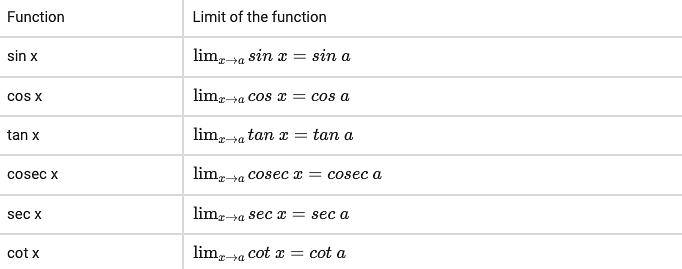Question:
$\displaystyle \lim_{x\to0}\left(\frac{\tan \,x}{\sqrt{2x +4} - 2}\right)$ is equal to
$\displaystyle \lim_{x\to0}\left(\frac{\tan \,x}{\sqrt{2x +4} - 2}\right)$ is equal to
Updated On: May 30, 2022
- 2
- 3
- 4
- 6
Hide Solution
Verified By Collegedunia
The Correct Option is A
Solution and Explanation
$\displaystyle\lim_{x \rightarrow 0}\left(\frac{\tan \,x}{\sqrt{2 x+4}-2}\right) \,\,\,\left[\frac{0}{0}\right]$ form
Applying L' Hopitals' rule, we get
$\displaystyle\lim _{x \rightarrow 0}\left(\frac{\sec ^{2} x}{\frac{2}{2x\sqrt{2x +4}}-0}\right)$
$=\displaystyle\lim _{x \rightarrow 0}\left((\sqrt{2 x+4}) \sec ^{2} x\right)$
$=\sqrt{2 \times 0+4} \times 1=2$
Applying L' Hopitals' rule, we get
$\displaystyle\lim _{x \rightarrow 0}\left(\frac{\sec ^{2} x}{\frac{2}{2x\sqrt{2x +4}}-0}\right)$
$=\displaystyle\lim _{x \rightarrow 0}\left((\sqrt{2 x+4}) \sec ^{2} x\right)$
$=\sqrt{2 \times 0+4} \times 1=2$
Was this answer helpful?
0
0
Top Questions on limits of trigonometric functions
- The value of \( \lim_{x \to 0} \left( \frac{\tan 11x}{\tan 5x} \right) \) is:
- GATE MN - 2025
- Engineering Mathematics
- limits of trigonometric functions
- Find the value of the following expression: \[ \tan^2(\sec^{-1}4) + \cot(\csc^{-1}3) \]
- MHT CET - 2025
- Mathematics
- limits of trigonometric functions
- Given a real-valued function \( f \) such that: \[ f(x) = \begin{cases} \frac{\tan^2\{x\}}{x^2 - \lfloor x \rfloor^2}, & \text{for } x > 0 \\ 1, & \text{for } x = 0 \\ \sqrt{\{x\} \cot\{x\}}, & \text{for } x < 0 \end{cases} \] Then:
- BITSAT - 2024
- Mathematics
- limits of trigonometric functions
- Evaluate the limit: \[ \lim_{\theta \to \frac{\pi}{2}} \frac{8\tan^4\theta + 4\tan^2\theta + 5}{(3 - 2\tan\theta)^4} \]
- TS EAMCET - 2024
- Mathematics
- limits of trigonometric functions
- If \( f(x) \) is defined as follows:
\[ f(x) = \begin{cases} \frac{x - \lfloor x \rfloor}{x - 2} & \text{if } x = 2 \\ \frac{|x - \lfloor x \rfloor|}{a^2 + (x - \lfloor x \rfloor)^2} & \text{if } 1 < x < 2 \\ 2a - b & \text{if } x = 1 \end{cases} \]
Then the limit \( \displaystyle \lim_{x \to 0} \frac{\sin(ax) + x \tan(bx)}{x^2} \) is:- AP EAPCET - 2023
- Mathematics
- limits of trigonometric functions
View More Questions
Questions Asked in KCET exam
- If the number of terms in the binomial expansion of \((2x + 3)^n\) is 22, then the value of \(n\) is:
- KCET - 2025
- Binomial theorem
- Ethyl alcohol is heated with concentrated sulphuric acid at 413 K (140°C). The major product formed is
- KCET - 2025
- Organic Chemistry
- A body of mass 0.25 kg travels along a straight line from \( x = 0 \) to \( x = 2 \, \text{m} \) with a speed \( v = k x^2 \) where \( k = 2 \, \text{m}^{-1} \). The work done by the net force during this displacement is
- KCET - 2025
- Elastic and inelastic collisions
- A square loop of side 2 m lies in the Y-Z plane in a region having a magnetic field \(\mathbf{B} = (5 \hat{i} - 3 \hat{j} - 4 \hat{k}) \, \text{T}\). The magnitude of magnetic flux through the square loop is
- KCET - 2025
- Magnetic Field
- A random experiment has five outcomes \(w_1, w_2, w_3, w_4, w_5\). The probabilities of the occurrence of the outcomes \(w_1, w_2, w_4, w_5\) are respectively \( \frac{1}{6}, a, b, \frac{1}{12} \) such that \(12a + 12b - 1 = 0\). Then the probabilities of occurrence of the outcome \(w_3\) is:
- KCET - 2025
- Probability
View More Questions
Concepts Used:
Limits of Trigonometric Functions
Assume a is any number in the general domain of the corresponding trigonometric function, then we can explain the following limits.

We know that the graphs of the functions y = sin x and y = cos x detain distinct values between -1 and 1 as represented in the above figure. Thus, the function is swinging between the values, so it will be impossible for us to obtain the limit of y = sin x and y = cos x as x tends to ±∞. Hence, the limits of all six trigonometric functions when x tends to ±∞ are tabulated below:
